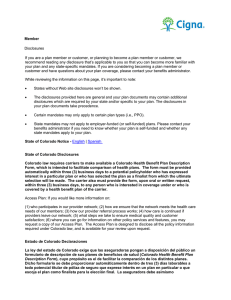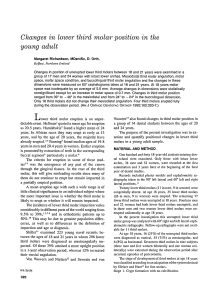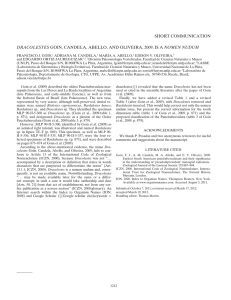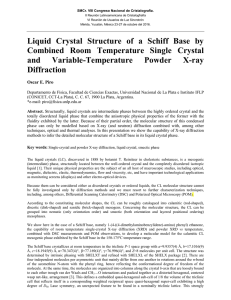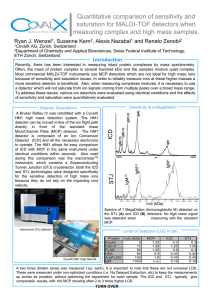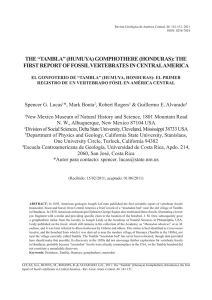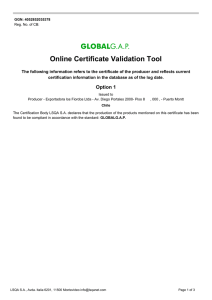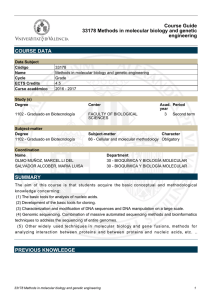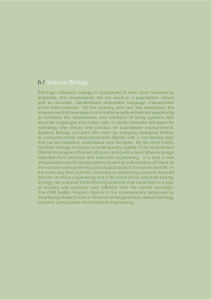non intrinsic contribution to the limiting partial molar volume of globular proteins in water
Anuncio
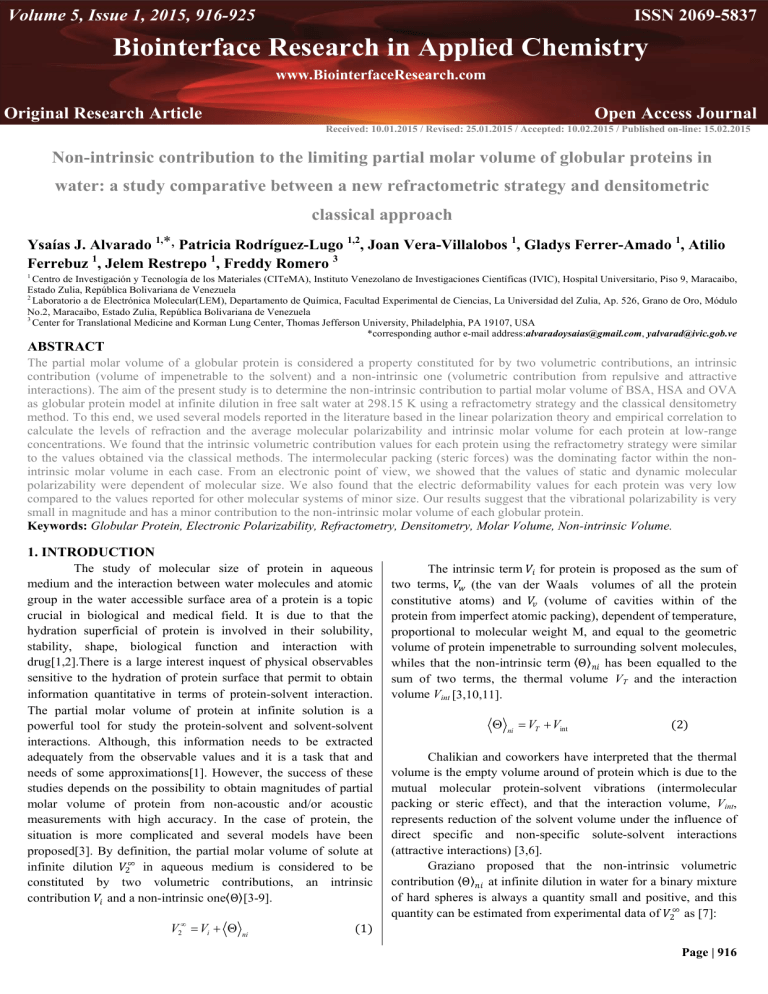
Volume 5, Issue 1, 2015, 916-925 ISSN 2069-5837 Non-intrinsic Contribution to the Partial Molar Volume at Infinite Dilution of BSA, HSA and OVA in water from a Strategy Refractometric Biointerface Research in Applied Chemistry www.BiointerfaceResearch.com Original Research Article Open Access Journal Received: 10.01.2015 / Revised: 25.01.2015 / Accepted: 10.02.2015 / Published on-line: 15.02.2015 Non-intrinsic contribution to the limiting partial molar volume of globular proteins in water: a study comparative between a new refractometric strategy and densitometric classical approach Ysaías J. Alvarado 1,*, Patricia Rodríguez-Lugo 1,2, Joan Vera-Villalobos 1, Gladys Ferrer-Amado 1, Atilio Ferrebuz 1, Jelem Restrepo 1, Freddy Romero 3 1 Centro de Investigación y Tecnología de los Materiales (CITeMA), Instituto Venezolano de Investigaciones Científicas (IVIC), Hospital Universitario, Piso 9, Maracaibo, Estado Zulia, República Bolivariana de Venezuela 2 Laboratorio a de Electrónica Molecular(LEM), Departamento de Química, Facultad Experimental de Ciencias, La Universidad del Zulia, Ap. 526, Grano de Oro, Módulo No.2, Maracaibo, Estado Zulia, República Bolivariana de Venezuela 3 Center for Translational Medicine and Korman Lung Center, Thomas Jefferson University, Philadelphia, PA 19107, USA *corresponding author e-mail address:[email protected], [email protected] ABSTRACT The partial molar volume of a globular protein is considered a property constituted for by two volumetric contributions, an intrinsic contribution (volume of impenetrable to the solvent) and a non-intrinsic one (volumetric contribution from repulsive and attractive interactions). The aim of the present study is to determine the non-intrinsic contribution to partial molar volume of BSA, HSA and OVA as globular protein model at infinite dilution in free salt water at 298.15 K using a refractometry strategy and the classical densitometry method. To this end, we used several models reported in the literature based in the linear polarization theory and empirical correlation to calculate the levels of refraction and the average molecular polarizability and intrinsic molar volume for each protein at low-range concentrations. We found that the intrinsic volumetric contribution values for each protein using the refractometry strategy were similar to the values obtained via the classical methods. The intermolecular packing (steric forces) was the dominating factor within the nonintrinsic molar volume in each case. From an electronic point of view, we showed that the values of static and dynamic molecular polarizability were dependent of molecular size. We also found that the electric deformability values for each protein was very low compared to the values reported for other molecular systems of minor size. Our results suggest that the vibrational polarizability is very small in magnitude and has a minor contribution to the non-intrinsic molar volume of each globular protein. Keywords: Globular Protein, Electronic Polarizability, Refractometry, Densitometry, Molar Volume, Non-intrinsic Volume. 1. INTRODUCTION The study of molecular size of protein in aqueous medium and the interaction between water molecules and atomic group in the water accessible surface area of a protein is a topic crucial in biological and medical field. It is due to that the hydration superficial of protein is involved in their solubility, stability, shape, biological function and interaction with drug[1,2].There is a large interest inquest of physical observables sensitive to the hydration of protein surface that permit to obtain information quantitative in terms of protein-solvent interaction. The partial molar volume of protein at infinite solution is a powerful tool for study the protein-solvent and solvent-solvent interactions. Although, this information needs to be extracted adequately from the observable values and it is a task that and needs of some approximations[1]. However, the success of these studies depends on the possibility to obtain magnitudes of partial molar volume of protein from non-acoustic and/or acoustic measurements with high accuracy. In the case of protein, the situation is more complicated and several models have been proposed[3]. By definition, the partial molar volume of solute at infinite dilution 𝑉𝑉2∞ in aqueous medium is considered to be constituted by two volumetric contributions, an intrinsic contribution 𝑉𝑉𝑖𝑖 and a non-intrinsic one⟨Θ⟩[3-9]. V2∞ = Vi + Θ ni (1) The intrinsic term 𝑉𝑉𝑖𝑖 for protein is proposed as the sum of two terms, 𝑉𝑉𝑤𝑤 (the van der Waals volumes of all the protein constitutive atoms) and 𝑉𝑉𝑣𝑣 (volume of cavities within of the protein from imperfect atomic packing), dependent of temperature, proportional to molecular weight M, and equal to the geometric volume of protein impenetrable to surrounding solvent molecules, whiles that the non-intrinsic term ⟨Θ⟩𝑛𝑛𝑛𝑛 has been equalled to the sum of two terms, the thermal volume VT and the interaction volume Vint [3,10,11]. Θ ni = VT + Vint (2) Chalikian and coworkers have interpreted that the thermal volume is the empty volume around of protein which is due to the mutual molecular protein-solvent vibrations (intermolecular packing or steric effect), and that the interaction volume, Vint, represents reduction of the solvent volume under the influence of direct specific and non-specific solute-solvent interactions (attractive interactions) [3,6]. Graziano proposed that the non-intrinsic volumetric contribution ⟨Θ⟩𝑛𝑛𝑛𝑛 at infinite dilution in water for a binary mixture of hard spheres is always a quantity small and positive, and this quantity can be estimated from experimental data of 𝑉𝑉2∞ as [7]: Page | 916 Non-intrinsic contribution to the limiting partial molar volume of globular proteins in water: a study comparative between a new refractometric strategy and densitometric classical approach Θ ni = V2∞ − Vi (3) The equation (3) is commonly used with densitometric data of 𝑉𝑉2∞ (this quantity non-intrinsic in this work is henceforth referred to as ⟨Θ⟩𝑑𝑑𝑛𝑛𝑛𝑛 ). Therefore, it will be useful have an alternative method that permits one to estimate the non-intrinsic volumetric contribution ⟨Θ⟩𝑛𝑛𝑛𝑛 at infinite dilution for to realize studies comparatives with those values deduced via densitometryanalysis. In this equation, the translational 0 contribution (𝛽𝛽1𝑇𝑇 𝑅𝑅𝑅𝑅) is not considered by their low magnitude in comparison with the magnitude of partial molar volume of protein. Interestingly, Fucaloro [12], has showed that values of partial molar volume with very low errors can be obtained from densities of liquid mixtures using refractometry and the LorentzLorenz’s equation. Based on this consideration and continuing with our interest in this field [13-16], we report in this work the experimental determination of the non-intrinsic contribution (henceforth refereed as ⟨Θ⟩𝑟𝑟𝑛𝑛𝑛𝑛 ) to the limiting partial molar volume 𝑉𝑉2∞ of Ovalbumin (OVA), Bovine Serum Albumin (BSA) and Human Seric Albumin (HSA) - three globular protein models - at 298.15 K and atmospheric pressure in water free salt as solvent using high resolution refractometry [13,16] and a strategy based in the model of electronic polarization proposed by KohnerGeffcken-Grunwald-Haley (KGGH) [14,17]. The original version of this model described that the partial molar volume 𝜙𝜙 𝑅𝑅2𝑚𝑚 𝜙𝜙 𝑉𝑉2 and are related to apparent electronic molar refraction of solute the refraction of solution, Φ𝑠𝑠 , by the following expression: Φ= s 6n1(υ ) ( n(υ ) − n1(υ ) ) = 2 ( n1(2υ ) + 2 ) φ n1(2 υ ) − 1 φ R2 m − 2 V2 C2 (4) n1(υ ) + 2 were the symbols C, 𝑛𝑛(𝜐𝜐) , and 𝑛𝑛1(𝜐𝜐) representing the concentration of solute (mol/cm3), the refractive indices of solution and solvent at optical frequency,𝜐𝜐, represented as wavenumbers respectively. If this equation on the right-hand side is substituted the equation (1), used the definition (n (υ ) − n1(υ ) ) C2 ∂n(υ ) = ∂C2 C2 → 0 and rearranging, one may to obtain the relationship that permit estimated the non-intrinsic contribution to the limiting partial molar. R2∞m − Γ (υ ) r = Θ ni Φ 1(υ ) − Vi (5) 6n n1(2 υ ) − 1 ∂n(υ ) 1(υ ) , and Here Γ (υ ) = Φ = 2 . As 1(υ ) n 2 + 2 2 ∂C2 n1(υ ) + 2 C → 0 2 1(υ ) ∞ at dilution in this strategy is necessary know the magnitude of 𝑅𝑅2𝑚𝑚 ∞ infinite and 𝑉𝑉𝑖𝑖 , we calculate 𝑅𝑅2𝑚𝑚 using the relation ( ) R2∞m = ( 4π N 3) α 2(e υ ) , -here N is Avogadro’s number-, and the 𝑒𝑒 of each protein of average molecular polarizability value 𝛼𝛼2(𝜐𝜐) 𝑒𝑒 of molecular weight M 2 . For our recognition the values of 𝛼𝛼2(𝜐𝜐) each protein were experimental obtained from some theoretical and experimental models previously reported only for small molecules and polymers, but not used for proteins[14,17-19], while that 𝑉𝑉𝑖𝑖 was calculated in each case using the empirical method previously reported by Chalikian and co-workers[10,20]. The values obtained for three proteins using the refractometric strategy were compared with those estimated following the classical densimetric method. 2. EXPERIMENTAL AND THEORETICAL METHODS 2.1. Determination of the non-intrinsic contribution to the partial molar volume at infinite dilution of globular protein by the refractometric method. Bovine serum albumin (BSA, 66430 g-mol-1 ), Human serum albumin (HSA, 66437 g-mol-1 ) and Ovalbumin (OVA, 45000 g-mol-1) were purchased from Sigma Aldrich and used without further purification. The solutions were prepared by dissolving the lyophilized powder with bi-distilled, deionized water (18 MΩ resistence). The concentration of each protein was determined by UV-Vis spectroscopy using the value of molar absorption coefficient reported in literature [21,22]. The concentrations C2 of each protein ranged from 1.26 x 10-3 to 42.03 x 10-3 g·cm−3 for BSA, 1.79 x 10-3 to 33.22 x 10-3 g·cm−3 for HSA, and 1.33 x 10-3 to 66.30 x 10-3 g·cm−3 for OVA. The concentration range was based in the solubility of each protein in pure water. The pH values of the solutions prepared fluctuated very close to neutral pH (6.8). The refractive index, n ,of both water and binary solutions, were measured with Anton Paar Abbemat MW refractometer equipped with a high-resolution CCD sensor, Fresnel analysis and a LED as light source at 298.15 ± 0.03 K (Peltier effect). The wavelength was tuned in the range of 436.5 – 657.7 nm using an interference filter, the precision in the wavelength was ± 0.2 nm. The densities of solutions ρ, as well as the water solvent density ρ1, were determined at 298.15 K and atmospheric pressure using a variable-temperature Anton-Paar DSA-5000 acoustic densitometer calibrated before each series of measurements with bi-distilled, deionized and degassed water (18 M Ω. cm resistence) and dry air [23]. Additionally, benzene (> 99.8%, Merck, spectroscopic grade) was used as a test liquid, and the density measured in this work (0.879010 g·cm−3) has shown excellent concordance with published data (0.878914, 0.878800, 0.878660 and 0.878914 g·cm−3)[14,24]. Each density value was determined by measuring the oscillation of a U-tube sample cell with a sample volume of 3.5 cm3. For Water solvent, the values of density ρ1 (0.997069 g·cm−3), and refraction index n1(υ) (1.331538) at 589.9 nm obtained in this work at 298.15 K are in agreement with previously reported values [25,26]. The refraction index of each protein 𝑛𝑛2(𝜐𝜐) at optical frequency, 𝜐𝜐, represented in this work as wavenumbers was estimated from the value of refractive index of Page | 917 Ysaías J. Alvarado, Patricia Rodríguez-Lugo, Joan Vera-Villalobos, Gladys Ferrer-Amado, Atilio Ferrebuz, Jelem Restrepo, Freddy Romero solution following the additive model proposed by Mershin and co-workers for tubulin [27]. The values of density of solvent and binary solutions, refractive index of solutions and each protein obtained in this work are collected and shown in the tables S1-S3 of the supplementary material. The procedure allowed us to determine that the reproducibility of the experimental refractive index and densities was better than 1 × 10−6 in each case. The dynamic mean electronic molecular polarizability of each protein in binary mixture was estimated using these data and the following models: Proutiere equation[19] (eq. 6, P model ), Singer-Garito equation[18] (equations 7, S-GL model and 8, S-GO model), and the model proposed by Baird and co-works[28] (equation 9, L-L model): 3M Φ 6n M ∂n 1(υ ) (υ ) 2 (υ ) 2 α 2(e υ ) = + 2 2 4π N ρ1 C ∂ ( n(υ ) + 2 ) 2 C α e 2(υ ) − 2 →0 Φ (υ ) ∂ρ (6) ρ ∂C2 C → 0 2 ( ) ∂ 1 1 ∂n(υ ) 3M 2 3ρ1 ρ ρ + + 1 2 2 4π N ρ ( n + 2 ) ∂C2 C → 0 ρ C ∂ 2 1(υ ) 2 molecular polarizability estimated with the equation (6) was taken as the reference in each case - only the equation (6) has been used in studies with very big polymers -. The non-intrinsic contribution Θ r to the limiting partial ni molar volume of each protein was determined using the refractometric data and equation (5), the value of dynamic mean electronic molecular polarizability and intrinsic volume Vi of each protein. The intrinsic molar volume of each protein was calculated following the approximation proposed by Chalikian and coworkers = (Vi 1200 + 1.04M 2 ) [6,10,20]. 2.2. Determination of the non-intrinsic contribution to the partial molar volume at infinite dilution of globular protein by the densitometric method. In a two-component system, the apparent molar volume of the solute 𝑉𝑉2∅ can be calculated from the measured densities of the solutions, ρ, through the relationship: Φ1(υ ) C2 → 0 M ρ − ρ1 = V2φ 2 − 103 (10) ρ1 ρ1 However, for very dilute solutions, the V2φ values are (7) independent of the concentration (mol-L-1) and therefore by α 2(e υ ) ρ1 M 2 4π N ρ f ( n 2 (υ ) ) ∂n(υ ) + ∂C2 C2 →0 + ρ1 M 2 ( n1(2 υ ) + 2 ) ∂ 4π Nf ( n2 (υ ) ) definition it can be assumed that V2∞ is equal to the average values of V2φ determined within the studied concentration range[14]. ( 1 ρ ) ∂C2 1 1 ∂n(υ ) (8) + − 2 ∂ ρ C 3 n ρ 2 1( ) υ 0 C → 2 C2 → 0 ∂n 9 M 2 n1(υ ) 3Φ1(υ ) ∂ρ (υ ) = − − M 2 (9) α 2 2π N n 2 + 2 ∂C2 ( 1(υ ) ) C2 →0 4π N ρ1 ∂C2 C2 →0 The Partial molar volumes at infinite dilution V2∞ (cm3mol−1) of each protein in water was estimated using the densities experimentally measurements and following the three-term Redlich equation[14,16]. ρ= ρ1 + B1C2 + B2 C22 (11) e 2(υ ) ( ) ) n12(υ ) n22(υ ) + 2 n(2υ ) − 1 Were Φ (υ ) = 2 and f ( n ) = ( ) 2n12(υ ) + 2n22(υ ) n(υ ) + 2 2 υ ( Excellent linear relationships were found for the density, 𝜌𝜌 , specific volumes, ( 1⁄𝜌𝜌 ), refractive index or square of the refractive indices of solutions of the protein studied at each frequency of the applied electric field against their solute mass concentration C2 (g-cm-3) (see Table S4 supplementary material). The reproducibility obtained for these slopes was very high and then the uncertainties in the dynamic mean electronic molecular 𝑒𝑒 polarizabilities 𝛼𝛼2(𝜐𝜐) obtained in this work were between 0.93 and 1.1 %. In this work, the value of dynamic mean electronic here= B1 (( M 2 − ρ1V2∞ ) 103 ) B2 = ( ( Bv ρ1 ) 103 ) , and Bv is an empirical constant, and represents the contributions of nonspecific and specific interactions and modification, creation or destruction of solvent structure promoted by solute-solute interactions [14,29]. Least-square analyses of the experimental data were performed using the MICROSOFT EXCEL software package. The non-intrinsic contribution Θ d ni to the experimental ∞ 2 partial molar volume at infinite dilution V of each protein was estimated using the relation (1), (3) and the Vi values here theoretically estimated using the relationship proposed by Chalikian and co-workers [6,10,20] as describe in the previous section. 3. RESULTS SECTION 3.1. Partial molar volume 𝑽𝑽∅𝟐𝟐 and non-intrinsic ⟨𝚯𝚯⟩𝒅𝒅𝒏𝒏𝒏𝒏 molar volume at infinite dilution of BSA, HSA and OVA in solutions of free-salt water via densitometry. The densities obtained were fitted to a lineal model (twoterm Redlich equation) and quadratic model (three-term Redlich equation) by means of the least-squares method (see Tables S5-S7 of supplementary material). A statistical comparison of figures of merit (correlation coefficient, significance levels and residuals) revealed no significant difference between these two models (graph omitted for simplicity). In fact, the correlation coefficientvaried from the fourth decimal place between models. The significance levels were similar in the both models in all cases (see Table S5-S7). However, the error obtained for B2 slope of the quadratic model is very high in all cases. The values of limiting Page | 918 Non-intrinsic contribution to the limiting partial molar volume of globular proteins in water: a study comparative between a new refractometric strategy and densitometric classical approach partial molar volume V2∞ obtained from the two-term Redlich equation and the lineal least-square fitting method for each protein as shown in Table I. The experimental errors in the partial molar volume obtained by an error propagation analysis were in all cases less than 1%. Also, the limiting partial molar volume of each protein 𝑉𝑉2∞ showedno statistical differences between values obtained by the linear and quadratic models. The values obtained in each case showed an excellent agreement compared to the values calculated using the average of values of the partial molar volume of protein (Table 1).With the exception of HSA, the value determined of 𝑉𝑉2∞ between both models shown a difference of 2.23 %. Table 1. Partial molar volume at infinite dilution of each protein determinate from different methodologies, theoretical values of intrinsic volume and non-intrinsic molar volume estimated via densitometry PROTEIN V2∞ /cm3-mol-1 a b c ∞ 2 V /cm3-mol-1 ∞ 2 V /cm -mol 3 -1 BSA OVA HSA 49452.59 35188.54 49597.56 49110.45 35138.20 49790.46 49310.32 35149.11 48687.80 d d 50252 d ∞ 2 V /cm -mol 3 -1 e 65016.11 33810 e 39954.33 f f 49245 3 Vi/cm -mol -1 ⟨Θ⟩𝑑𝑑𝑛𝑛𝑛𝑛 /cm3-mol-1 a Estimated as b 𝑉𝑉2∞ = 49312 42326.95 28905.60 42331.34 6783.50 6232.60 7459.12 ∑𝑛𝑛𝑖𝑖=1�𝑉𝑉2,𝜑𝜑 � ⁄𝑛𝑛 𝑖𝑖 Estimated from Lineal Fit two term Redlich equation (see Eq.11) Estimated from Cuadratic Fit three term Redlich equation (see Eq.11) d Reported Ref.[20]eReported Ref. [30]fReported Ref. [31] c The results suggest that the microenvironment (solvation shell) of each protein in water remains constant and that the proteins have a very low tendency to form dipolar clusters by selfassociation in this solvent in the studied concentration range. As the experiments are carried out at pH 6.8, the protein has a high negative surface charge, as a consequence, is expected that the electrostatic protein-protein repulsion become dominant. In line with these results, Ikeda and Nishinari have shown that large interparticle repulsive forces stabilized native OVA aqueous solutions [26,32]. And thus, Minton and Fernandez have recently reported that the protein-protein self-association is neglect in solutions concentrated of BSA and OVA using static light scattering [32]. Curiously, Singh and co-workers reported the selfassociation of BSA and OVA[30] in a concentration range similar to used in the present work, while, Iqbal and Verrall [31] reported the self-association of BSA and HSA in a concentration range lower than the reported by Minton and Fernandez [32]. It is very important consideredthat the method reported by Minton and Fernandezis able to discriminate between the presence of monomers, dimers, trimers and high aggregates of protein in solution because these authors developed a new automated dilution system coupled to light scattering equipment that provides a high improvement in the experimental data precision at wide range of concentration. Based in these arguments, we considered that the lineal model described more adequately the results observed for dependence of solution density with the molar concentration. On the other hand, our results showed that the values of 𝑉𝑉2∞ for BSA and OVA are comparable to the values reported previously by Chalikian and co-workers for these proteins in water at the concentration of 3 mg-ml-1 [20], and to the value reported by El Kadi and co-workers [33] for BSA at pH ~7. In addition, these results are in agreement with the value reported for BSA and HSA by Iqbal and Verrall at same temperature and pressure [31]. In contrast, our results differ from those reported by Singh and coworkers[30] at infinite dilution of BSA and OVA (see Table I). As expected, the results of 𝑉𝑉2∞ showed the following order: HSA ~ BSA > OVA. Additionally,the Table I showsthe values obtained in this work for the intrinsic molar volume Vifor BSA and HSA using the method proposed by Chalikian and co-workers [6,10,20], in this table can to see too the value for OVA report by the same authors under this formalism [19].The non-intrinsic molar volume at infinite dilution, ⟨Θ⟩𝑑𝑑𝑛𝑛𝑛𝑛 , determined as the difference between experimental value 𝑉𝑉2∞ obtained via acoustic densitometry and the respective intrinsic volume Viof each protein was a positive quantity in each case, and its magnitude was 7459.12, 6783.50 and 6232.60 cm3-mol-1 for HSA, BSA and OVA, respectively(see Table I), as a consequence, this contribution represent around of 15 % (HSA), 13.8 % (BSA) and 17.7% (OVA) to the limiting partial molar volume. This contribution contain the volumetric contribution from the intermolecular packing (repulsive interactions) and the solute-solvent attractive interactions. This non-intrinsic contribution ⟨Θ⟩𝑑𝑑𝑛𝑛𝑛𝑛 not exhibited marketed dependence with the molecular size of protein. It is important to clarify the molecular origin of these results. For definition, ⟨Θ⟩𝑑𝑑𝑛𝑛𝑛𝑛 has two contributions (see equation 2), the first contribution (repulsive interactions) to non-intrinsic volume is positive and second contribution is a negative quantity become from attractive interactions, and in consequence, the positive and high magnitude of ⟨Θ⟩𝑑𝑑𝑛𝑛𝑛𝑛 obtained for these macromolecules is due to that the balance between these two quantities, which is dominate by steric repulsions from thermal volume. These results suggest that the excluded volume packing effects (steric interactions) have an important and dominant role upon the non-intrinsic contribution to partial molar volume at infinite dilution of these proteins. Although, the magnitude relative of the van der Waals forces does not stop being important; due to that the hydration effects are takes accounts only in the interaction volume. In fact, Ben-Naim has shown the importance of the specific attractive interactions between water molecules and hydrophilic groups on the surface of protein for overall Gibbs solvation energy of proteins in water [32,34]. 3.2. Mean electronic molecular polarizability 𝜶𝜶∞ 𝟐𝟐(𝝊𝝊) and non𝑟𝑟 intrinsic ⟨Θ⟩𝑛𝑛𝑛𝑛 to molar volume at infinite dilution of BSA, HSA and OVA in solutions of free-salt water via refractometry. Prior to the discussion of results about the static and dynamic mean molecular electronic polarizabilities of protein 𝑒𝑒 𝛼𝛼2(𝜐𝜐) (see table II), it is important to discusin relation to the values obtained in this work of protein refractive index increment, due the number of experimentally measured values for protein in water Page | 919 Ysaías J. Alvarado, Patricia Rodríguez-Lugo, Joan Vera-Villalobos, Gladys Ferrer-Amado, Atilio Ferrebuz, Jelem Restrepo, Freddy Romero solvent, pH and temperature [36]. In fact, Ball and Ramsden reported the buffer dependence of refractive index increments of lysozyme solutions [37]. However, Silva and co-workers reported a magnitude for this property independent of pH or ionic strength of 0.180 cm3- g-1 for BSA in saline solution at 632.8 nm and 298.15 K by ellipsometry [38]. pure is very limited [35,36]. Despite the great importance of this property, there have been very few systematic studies of these globular protein models in water pure (free additives). Conversely, there are scarce reports of the optical dispersion of this property for these proteins only some dynamic values and predominantly in saline medium and buffers [36]. It is very too important to mention that this property is affected by the dielectric nature of Table 2. Dynamic and static electronic molecular polarizability and the corresponding values of non-intrinsic molar volume of each protein obtained from via refractometric method. Polarization Model υ µm-1 2.290426 2.050441 1.828822 1.695203 1.520450 f a P f α 2e( 0) x10-21 g A1x10-23 6.932 6.853 6.808 6.776 6.748 6.599 6.234 S-GL 5.172 5.123 5.09 5.064 5.048 4.945 4.279 O 6.871 6.791 6.748 6.718 6.690 6.543 6.124 6.947 6.869 6.828 6.791 6.764 6.616 6.198 b BSA c S-G d L-L a P 4.472 4.422 4.385 4.357 4.343 4.233 4.533 b L 3.497 3.464 3.439 3.419 3.408 3.334 3.101 c O 4.442 4.392 4.355 4.277 4.316 4.245 2.525 4.043 3.996 3.962 3.939 3.924 3.824 4.139 S-G OVA α 2e(υ ) x10-21 S-G d L-L a 6.958 6.887 6.824 6.788 6.468 6.603 6.708 b P L 5.224 5.178 5.138 5.111 5.096 4.988 4.477 c O 6.873 6.805 6.745 6.695 6.692 6.524 7.183 6.940 6.867 c Eq. 8 6.805 6.774 d Eq. 9 6.749 6.587 6.659 S-G HSA S-G d L-L Estimate with: a Eq. 6 f cm3 (esu)-molecule-1 b Eq. 7 g cm3(esu)-molecule-1μm-2 The value of refractive index obtained in this workfor the three proteins increases with the frequency of applied electric field (Table S4). Perlmann and Longsworth a long time ago behind reported a similar behavior for the dispersion of this property of these proteins at 273.65 K and pH 4.95 (OVA), 5.05 (BSA) and 4.85 (HSA) – isoelectric point of each protein - using electrophoresis and differential prism method, but the magnitude in each case was lower than the obtained by us [39]. Interestingly, the comparison of the dynamic value determinate in this work for HSA at 589.9 nm with respect to the theoretical mean value (0.190 cm3- g-1) reported by Zhao and coworkers [35] which is based on the amino acid composition for Human proteins at 589 nm give a variation of 2.7 %. Similar variation was observed between our dynamic value at same frequency of BSA and the value (0.183 cm3 - g-1) reported at 589.3 nm in water[40]. On the other hand, our dynamic value at 657.7 nm for this same protein only have a difference of 1.6 % with respect to the values reported at 633 nm using refractometry and 2.5 % employing light scattering spectroscopy, respectively [41] and has a variation of 1.3 % with the value reported at 840 nm using SPR by Tumolo and co-workers [42]. It should be noted that for all the systems studied of molecular radius 𝑟𝑟2 the approximation 𝜆𝜆⁄𝑟𝑟2 ≫ 1 is accomplished; therefore, the radiation and protein interaction should be considered anelectrostatics problem[28], andthe use of the refraction equations (equations. (6) to (9)) isactually valid. And e Eq. 5 then, the dynamic mean electronic molecular polarizabilities 𝑒𝑒 determined 𝛼𝛼2(𝜐𝜐) for BSA, HSA, and OVA in off-resonance region in dilute solutions of free-salt water from these data, and the models described previously (Eqs. 6 to 9) are shown in the Table II. To obtain the static mean apparent electronic molecular 𝑒𝑒 polarizability 𝛼𝛼2(0) of each protein from these dynamic data, the 𝑒𝑒 , was treated as a frequency-dependent dynamic property 𝛼𝛼2(𝜐𝜐) quantity and calculated at different wavelengths using the relation: 𝑒𝑒 𝑒𝑒 𝛼𝛼2(𝜐𝜐) = 𝛼𝛼2(0) + 𝐴𝐴1 𝜐𝜐 2 , the long-wavelength limit was obtained from an extrapolation to zero frequency of the plot between the dynamic mean polarizabilitiy versus the frequency 𝜐𝜐 (Cauchy-type dispersion curve). This curve allows the extrapolation of only the electronic part of this property, and as consequence, contributions from infrared-active modes (vibrational polarizability) are not considered in this work. In the figure 1 is shown the corresponding Cauchy-type dispersion curve of two terms obtained for the dynamic mean molecular electronic polarizability of each protein in water as solvent. The dynamic results of the mean molecular electronic polarizability of each protein obtained with equation (6) shows how this property increases with the frequency 𝜐𝜐 in each case. The corresponding static values and Cauchy coefficients 𝐴𝐴1 (this coefficient is related with oscillator force) are reported in Table II for three proteins here studied. A simple inspection of this table revealed that HSA and BSA have similar dynamic and static polarizabilities, while, OVA is the protein minus polarizable, and Page | 920 Non-intrinsic contribution to the limiting partial molar volume of globular proteins in water: a study comparative between a new refractometric strategy and densitometric classical approach that the dispersion of polarizability obtained for each protein is dominated by oscillator force in the UV region. Also, from these results is clear that the protein-protein long-range induced dipole– dipole interaction is very weak in these experimental conditions. Figure 1. Experimental dispersion curves of electronic molecular polarizability of BSA (□), HSA () and OVA () in water at 298.15 K obtained using the Lorenz-Lorentz local field and equation 6. On the other hand, a comparison of results obtained using the equation (6) with those values obtained from the equation (9) shows that they are very close in all cases here studies. While, the values obtained using the equation (7) are extremely low in comparison with the values determined employing the equations discussed previously (equations (6) and (9)). It is very important to notice that these equations are based in the same Lorentz and Lorenz local field but there are not studies about of its implementation for proteins. Although the performance of the equation (6) has been proved for polymers of lower and higher molecular mass than the present proteins [19]. While, the results dynamic and static of polarizability estimated with the Onsager local field approximation – this correction in equation (8) considerer the mutual polarization protein-solvent - are lower than those obtained from equation (6) and Lorentz-Lorenz local field in approximately a 1.5 % (HSA), 3.9 % (OVA) and 9.2 % (BSA), respectively (see Table II). Briefly, is very important to mention that for obtain these values is necessary determine thecorresponding refractive indices of proteins at each frequency assuming that the contributions from the mixture components are additive linearly to the index of refraction of the solution [27]. As shown in the Table S1-S3, for particular case of BSA and OVA, the apparent refraction indices of BSA and OVA at 589.9 nm are very close with those reported for hydrate BSA ( 𝑛𝑛 = 1.500000) and film of OVA (𝑛𝑛 = 1.555000) at the same wavelength [43,44]. Unfortunately, the experimental refractive indices and electronic polarizabilities for these proteins at these wavelength, solvent and pH are very scanty and a study comparative is not possible. In fact, Damodaran in their recent study about stabilization protein induced by co-solvents, had to used empirical additive methods for estimate the refractive indices of BSA at 279 nm and the IR region for this analysis[45,46]. Based in all these arguments, in the present work, we considered that the values obtained with equation (6) are experimentally corrects and the best set of electronic polarizability values. Therefore, the follow analysis of electronic response and the determination refractometric of the non-intrinsic contribution ⟨Θ⟩𝑟𝑟𝑛𝑛𝑛𝑛 to the partial molar volume at infinite dilution of BSA, HSA and OVA were carried out using these values as reference. The total electric deformability seen as the variation of polarizability at 436.6 nm with respect to the static value for each protein is 5.05 %, 5.38 % and 0.85 % for BSA, HSA and OVA, respectively. It is very important to note the low electric deformability (i.e., low electric distortion of the charge distribution) of these systems in comparison to the high electric deformability observed for very small aromatic and heteroaromatic molecules [18,47]. The low electric deformability suggests that amino acid residues locate in the interior or surface of protein have a different response to the electric field applied. Apparently, the contribution to total electronic polarizability of each amino acid residues buried in the interior is lower than the contribution of the functional groups exposed in the surface of protein. It is important to note that the protein interior is solid-like and the work cavity creation in their interior is more higher than in liquids [48]. These results suggest clearly that models based in additive contribution of atom or functional group polarizability are no adequate for protein under the perturbation of an electric field applied. In fact, Marenich, Cramer and Truhlar have theoretically shown that the electronic polarizabilities of interior atoms and functional groups in small molecules, nanoparticules and peptides are highly quenched and reduced in comparison with the same atoms or functional groups no buried or exposed [49]. On the other hand, in the figure 2 are shown the behavior of the non-intrinsic molar volume ⟨Θ⟩𝑟𝑟𝑛𝑛𝑛𝑛 with frequency of electric field applied using the equation (5) and employing the experimental values of electronic mean molecular polarizability (obtained with equation (6)), the value calculated of the intrinsic molar volume 𝑉𝑉𝑖𝑖 (see Table I) of each protein, refractive index increment of each protein (see Table S4) and the rest of experimental parameters relevant measured in this work. As can be seen in this figure, the magnitude of ⟨Θ⟩𝑟𝑟𝑛𝑛𝑛𝑛 no changed appreciably with the frequency of electric field applied, in fact, the difference point to point was minor to 0.9 % in all cases. In addition, the values obtained for ⟨Θ⟩𝑟𝑟𝑛𝑛𝑛𝑛 at 589.9 nm - take as reference - are very close to the volumetric value⟨Θ⟩𝑑𝑑𝑛𝑛𝑛𝑛 . Although, the values of ⟨Θ⟩𝑟𝑟𝑛𝑛𝑛𝑛 are slightly lower than the values of ⟨Θ⟩𝑑𝑑𝑛𝑛𝑛𝑛 for BSA and OVA, with exception of HSA, however, this difference lies within a 2.9 %. These results bring to the foreground the physical importance of considerer the relaxation or vibrational contribution to non-intrinsic term ⟨Θ⟩𝑑𝑑𝑛𝑛𝑛𝑛 . In this context, is know that the vibrational contribution to the molecular polarizability is vanishing at optical frequencies[50] due the nuclei in atom cannot follow the oscillating field at these frequencies, and then, the magnitude of ⟨Θ⟩𝑟𝑟𝑛𝑛𝑛𝑛 obtained follow the equation 5 no contain this contribution, while, the term ⟨Θ⟩𝑑𝑑𝑛𝑛𝑖𝑖 is expected to contain this contribution from relaxation of interatomic forces with modification of the equilibrium geometry. And then, the differences observed between ⟨Θ⟩𝑑𝑑𝑛𝑛𝑛𝑛 and ⟨Θ⟩𝑟𝑟𝑛𝑛𝑛𝑛 suggest that the vibrational contribution to non-intrinsic molar volume is very small and lower than a 3 %. In contrast, this vibrational contribution to the total polarizability of free amino acids in aqueous medium is a quantity important. Page | 921 Ysaías J. Alvarado, Patricia Rodríguez-Lugo, Joan Vera-Villalobos, Gladys Ferrer-Amado, Atilio Ferrebuz, Jelem Restrepo, Freddy Romero become from the intermolecular imperfect packing protein-water (steric interactions). Additionally, the question of why the refractive index increment of proteins varies in a narrow range is in our opinion clear from the rearrange of equation (5): � Figure 2. Dependence of the non-intrinsic contribution to the limiting partial molar volume (⟨Θ⟩𝑟𝑟𝑛𝑛𝑛𝑛 ) of each globular protein with the frequency of electric field applied (𝜐𝜐): () BSA, () OVA and () HSA. However, the magnitude of ⟨Θ⟩𝑟𝑟 ≅ ⟨Θ⟩𝑑𝑑 is another piece of evidence that makes clears the important role of the intermolecular electronic attractive and repulsive interactions on the structural reorganization of lattice of water in the shell around of protein, but the attractive forces do not becomes the dominant factor, the factor dominant within the non-intrinsic molar volume 𝜕𝜕𝑛𝑛 (𝜐𝜐 ) 𝜕𝜕𝐶𝐶2 � 𝐶𝐶2→0 = 2 �𝑛𝑛 12 +2� 6𝑛𝑛 1 (𝑅𝑅2𝑚𝑚 − Φ1 𝑉𝑉2∞ ) (12) The order of magnitude of mean polarizabilities of protein and 𝜙𝜙1 𝑉𝑉2∞ (electronic polarization of solvent coupled with the cavity occupied by solute) is similar and only for a protein of very 𝑒𝑒 high polarizability is valid that 𝛼𝛼2(𝑣𝑣) ≫ 𝜙𝜙1 𝑉𝑉2∞ and then the refractive index increment of proteins should be outside of this narrow range. Investigation about this topic is carried out actually by our group. Finally, our results showed that the refractometric approach is an attractive strategy to estimate the non-intrinsic contribution to the partial molar volume at infinite dilution of protein globular in free-salt solutions. Currently, we are trying to use this strategy to determine the contribution non-intrinsic to the partial molar volume at infinite dilution of protein-ligand complex. 4. CONCLUSIONS The static and dynamic electronic mean molecular polarizability obtained for BSA, HSA and OVA is significantly influenced by molecular size and local field. The polarizability of BSA and HSA are similar but higher than the obtained for OVA. The electric deformability is similar in these protein, but lower than that the observed for molecular heteroaromatic and aromatic systems of small size. Taking as reference the electronic polarizability obtained with the equation (6) (P model), the magnitude of the non-intrinsic contribution to partial molar volume at infinite dilution of BSA, HSA and OVA following the refractometric strategy proposed in this work is very close to the values obtained via classical densimetometric method. The refractometric method confirms for this non-intrinsic contribution to partial molar volume at infinite dilution a value high and positive for each protein. The values obtained via refractometric method are low sensitive to the frequency of electric field applied. The results suggest that the vibrational polarizability of protein has a very small influence on the non-intrinsic contribution to the partial molar volume at infinite dilution in each case. The experimental results obtained in this work will serve as reference for the theoretical treatment of electronic and volumetric properties of globular protein in free-salt water, as well as, studies based in the determination of molecular sizes, shapes, molecular weights, and other fundamental physical properties of these proteins. 5. REFERENCES [1] Imai T., Molecular theory of partial molar volume and its applications to biomolecular systems, Condensed Matter Physics, 10, 3, 343 - 361, 2007. [2] Timasheff S.N., Protein Hydratation, Thermodymamic Binding, and Preferential Hydratation, Biochemistry, 41, 46, 13473-13482, 2002. [3] Chalikian T.V., Breslauer K. J., On volume changes accompanying conformational transitions of biopolymers, Biopolymers, 39, 5, 619-626, 1996. [4] Cametti C., Marchetti S., Onori G., Lysozyme Hydration in Concentrated Aqueous Solutions. Effect of an Equilibrium Cluster Phase., Journal of Physical Chemistry B, 117, 104-110, 2013. [5] Chalikian T.V., Volumetric Properties of Proteins, Annu. Rev. Biophys. Biomol. Struct, 32, 207-235, 2003. [6] Chalikian T.V., Volumetric measurements in binary solvents: Theory to experiment, Biophysical Chemistry, 156, 1, 3-12, 2011. [7] Graziano G., Non-intrinsic contribution to the partial molar volume of cavities in water, Chemical Physics Letters, 429, 420-424, 2006. [8] Medvedev N.N., Voloshin V.P., Kim A.V., Anikeenko A.V., Geiger A., Culation of Partial Molar Volume and its Components for Molecular Dynamics Models of Dilute Solutions, Journal of Structural Chemistry, 54, 2, S271-S288, 2013. [9] Kharakoz D.P., Volumetric propertiesof proteins and their analogs in diluted water solutions 1. Partial volumens of amino acids at 15-55 °C, Biophysical Chemistry, 34, 115-125, 1989. [10] Chalikian T.V., Shek Y.L., Interactions of Glycine Betaine with Proteins: Insights from Volume and Compressibility Measurements, Biochemistry, 52, 672-680, 2013. [11] Yu I., Takayanagi M., Nagaoka M., Intrinsic Alterations in the Partial Molar Volume on the Protein Denaturation: Surficial KirkwoodBuff Approach, Journal of Physical Chemistry B, 113, 3543-3547, 2009. [12] Fucaloro A.F., Partial Molar Volumes from Refractive Index Measurements, Journal of Chemical Education, 79, 685-688, 2002. [13] AlvaradoYsaías J., Caldera-Luzardo J., De La Cruz C., FerrerAmado G., Michelena E., Silva P., Volumetric, Electric, and Magnetic Properties of Thioxanthen-9-one in Aprotic Solvents as Revealed by High-Precision Densitometry, High-Accuracy Refractometry and Magnetic Susceptibility Measurements and by DFT Calculations, Journal of Solution Chemistry, 35, 1, 29-49, 2006. [14] Alvarado YsaíasJ., Caldera-Luzardo J., Ferrer-Amado G., MancillaLabarca V., Michelena E., Determination of the Apparent Molar Refraction and Partial Molar Volume at Infinite Dilution of Thiophene-, Pyrrole- and Furan-2-Carboxaldehyde Phenylhydrazone Derivatives in Page | 922 Non-intrinsic contribution to the limiting partial molar volume of globular proteins in water: a study comparative between a new refractometric strategy and densitometric classical approach Acetonitrile at 293.15 K, Journal of Solution Chemistry, 36, 1, 1-11, 2007. [15] Alvarado Y., Cubillán N., Chacín-Molero E., Ferrer-Amado G., Hernández-Labarca P., Velazco W., Ojeda-Andara J., Marrero-Ponce Y., Arrieta F., Experimental and Theoretical Determination of the Limiting Partial Molar Volume of Indole in CCl4, Tetrahydrofuran and Acetonitrile at 293.15 K: A Comparative Study with Benzimidazole and Benzothiophene, Journal of Solution Chemistry, 39, 2, 277-290, 2009. [16] Alvarado Y. J., Ballestas-Barrientos A., Cubillán N., Morales-Toyo M., Ferrer-Amado G., Restrepo J., Preferential solvation of thiphene and furan-2-carboxaldehyde phenylhydrazone derivatives in DMSO-Water and DMSO-n-Octanol mixtures, Spectrochimica Acta Part A, 103, 361367, 2012. [17] Grunwald E., Haley J.F., Acid Dissociation Constant of Trifluoroacetic Acid in Water Measured by Differential Refractomatry, Journal of Physical Chemistry, 72, 1944-1948, 1968. [18] Alvarado Y. J., Labarca P. H., Cubillán N., Ososrio E., Karam A., Solvent Effect on the Electronic Polarizability of Benzonitrile., Z. Naturforsch., 58a, 68 - 74, 2003. [19] Illien B., Ying R., Molar Mass, Radius of Gyration and Second Virial Coefficient from new Static Light Scattering Equations for Dilute Solutions: Application to 21 (Macro)molecules, ChemPhysChem, 10, 7, 1097-1105, 2009. [20] Chalikian T.V., Totrov M., Abagyan R., Breslauer K.J., The Hydration of Globular Proteins as Derived from Volume and Compressibility Measurements: Cross Correlating Thermodynamic and Structural Data, Journal of Molecular Biology, 260, 4, 588-603, 1996. [21] Ghosh K.S., Sen S., Sahoo B.K., Dasgupta S., A spectroscopic investigation into the interactions of′ 3 -O-carboxy esters of thymidine with bovine serum albumin, Biopolymers, 91, 9, 737-744, 2009. [22] Taboada P., Barbosa S., Castro E., Gutiérrez-Pichel M., Mosquera V., Effect of solvation on the structure conformation of human serum albumin in aqueous-alcohol mixed solvents, Chemical Physics, 340, 1-3, 59-68, 2007. [23] Anton Paar G.H., Density and Sound Velocity Analyzer DSA 5000, Instruction Manual, 28-34, 2007. [24] Rudan-Tasic D., Klofutar C., Apparent molar volume and expansibility of cyclohexanol in benzene and cyclohexane, Monatsshefte für Chemie, 129, 1245-1257, 1998. [25] Lide D.R., CRC Handbook of Chemistry and Physics, 90, CRC Press, 2010. [26] Ikeda S., Nishinari K., Solid-Like mechanical behaviors of ovalbumin aqueous solutions, International Journal of Biological Macromolecules, 28, 315-320, 2001. [27] Mershin A., Kolomenski A.A., Schuessler H.A., Nanopoulos D.V., Tubulin dipole moment, dielectric constant and quantum behavior: computer simulations, experimental results and suggestions, Biosystems, 77, 1-3, 73-85, 2004. [28] Petty H.R., Crumb J. A., Anderson V.E., Arakawa E.T., Baird J. K., New differential Bottcher-Onsager method used to determine polarizability and apparent radius of tungstosilicate (SiO4(WO3)124-), The Journal of Physical Chemistry, 81, 8, 696-703, 1977. [29] Alvarado Y., Álvarez-Mon M., Baricelli J., Caldera-Luzardo J., Cubillán N., Ferrer-Amado G., Hassanhi M., Marrero-Ponce Y., Mancilla V., Rocafull M., San Antonio-Sánchez M., Ojeda-Andara J., ThomasL., Solubility of Thiophene-, Furan- and Pyrrole-2-Carboxaldehyde Phenylhydrazone Derivatives in 2.82 M; Aqueous DMSO at 298.15 K, Inhibition of Lymphoproliferation and Tubulin Polymerization: A Study Based on the Scaled Particle Theory, Journal of Solution Chemistry, 39, 8, 1099-1112, 2010. [30] Singh M., Structural Interactions of Globular Proteins - Bovine serum Albumin, Egg Albumin, and Lysozyme, in Aqueous Medium, Elucidated with Molar Volumes, Viscosities, Energy Functions, and IR Spectra from 293,15 to 303,15 K, Journal of Applied Polymer Science, 103, 1420 - 1429 2007. [31] Iqbal M., Verrall R. E., Volumetric Properties of Aqueous Solutions of Bovine Serum Albumin, Human Serum Albumin, and Human Hemoglobin, Journal of Physical Chemistry, 91, 1935 - 1941, 1987. [32] Minton A.P., Fernández C., Static Light Scattering Form Concentrated Protein Solutions II: Experimental Test of Theory for Protein Mixtures and Weakly Self-Associating Proteins, Biophysical Journal, 96, 1992-1998, 2009. [33] El Kadi N., Taulier N., Le Huérou J.Y., Gindre M., Urbach W., Nwigwe I., Kahn P.C., Waks M., Unfolding and Refolding of Bovine Serum Albumin at Acid pH: Ultrasound and Structural Studies, Biophysical Journal, 91, 9, 3397-3404, 2006. [34] Ben-Naim A., Inversion of the Kirkwood--Buff theory of solutions: Application to the water--ethanol system, The Journal of Chemical Physics, 67, 11, 4884-4890, 1977. [35] Zhao H., Brown P., Schuck, P., On the Distribution of Protein Refractive Index Increments, Biophysical Journal, 100, 9, 2309-2317, 2011. [36] Theisen A., Johann C., Deacon M.P., Harding S.E., Refractive Increment Data-Book for Polymer and Biomolecular Scientists, Nottingham University Press, 2000. [37] Ball V., Ramsden J.J., Buffer Dependence of Refractive Index Increments of Protein Solutions, Biopolymers, 46, 489-492, 1998. [38] Sliva R.A., Urzúa M.D., Petri D.F.S., Dubin P.L., Protein Adsorption onto Polyelectrolyte Layers: Effects of Protein Hydrphobicity and Charge Anisotrpy, Langmuir, 26, 17, 14032-14038, 2010. [39] Perlmann G.E., Longsworth L.G., The Specific Refractive Increment of Some Purified Proteins Journal of American Chemical Society, 70, 2719-2724, 1948. [40] Huglin M.B., Specific Refractive Index increments of polymers in dilute solution, John Wiley, 1991. [41] Fu D., Choi W., Sung Y., Oh S., Yaqoob Z., Park Y., Dasari R. R., Feld M.S., Ultraviolet refractometry using field-based light scattering spectroscopy, Optics Express, 17, 21, 18878-18886, 2009. [42] Tumolo T., Angnes L., Baptista M.S., Determination of the refractive index increment (dn/dc) of molecule and macromolecule solutions by surface plasmon resonance, Analytical Biochemistry, 333, 2, 273-279, 2004. [43] Hall S.A., Covert P.A., Blinn B.R., Shakeri S., Hore D.K., Rapid and Sensitive Polarization Measurement for Characterizing Protein Adsorption at the Solid-Liquid Interface, Journal of Physical Chemistry C, 117, 1796-1803, 2013. [44] Arakawa E.T., Tuminello P.S., Khare B.N., Milham M.E., Optical Properties of Ovalbumin in 0.130 - 2.50 mm Spectral Region, Biopolymers (Biospectroscopy), 62, 122 - 128, 2001. [45] Damodaran S., On the Molecular Mechanism of Stabilization of Proteins by Cosolvents: Role of Lifshitz Electrodynamic Forces, Langmuir, 28, 25, 9475-9486, 2012. [46] Pethig R., Dielectric and Electronic Properties of Biological Materials, John Wiley and Son, 1979. [47] Alvarado Y.J., Soscún H., Velazco W., Labarca P.H., Cubillan N., Hernández J., Dipole polarizability of the pyrazabole molecule in solution, Journal of Physical Organic Chemistry, 15, 12, 835-843, 2002. [48] Graziano G., Cavity size distribution in the interior of globular proteins, Chemical Physics Letter, 434, 316-319, 2007. [49] Marenich A.V., Cramer C.J., Truhlar D.G., Reduced and quenched polarizabilities of interior atoms, Chemical Science, 4, 2349-2356, 2013. [50] Gussoni M., Rui M., Zerbi G., Electronic and relaxation contribution to linear molecular polarizability. An analysis of the experimental values, Journal of Molecular Structure, 447, 163-215, 1998. 6. ACKNOWLEDGEMENTS The authors thank to the Fondo Nacional de Ciencia, Tecnología e Innovación (FONACIT, Proyecto Misión Ciencia subproyecto 2 No. G-2007000881 y el apoyo a grupos No. G-2005000403), Petro-Regional del Lago S.A and Instituto Zuliano de Investigaciones Tecnológicas (INZIT) for financial support of this work. Page | 923 Ysaías J. Alvarado, Patricia Rodríguez-Lugo, Joan Vera-Villalobos, Gladys Ferrer-Amado, Atilio Ferrebuz, Jelem Restrepo, Freddy Romero Supplementary Material Table S1. Experimental values of refractive index of water and binary solutions 𝑛𝑛(𝜐𝜐) ,apparent refractive index protein 𝑛𝑛2(𝜐𝜐) and densities ρ of BSA aqueous solutions at 298.15 K. υ (μm-1) 2.290426 2.050441 1.828822 1.695203 λ (nm) 436.6 487.7 546.8 589.9 a C2 (g-cm-3) x 10-3 n(υ) 0 1.339643 1.336506 1.333943 1.331538 1.26 1.339967 1.336829 1.334278 1.331848 2.93 1.340458 1.337334 1.334750 1.332341 5.04 1.341035 1.337897 1.335328 1.332891 6.30 1.341396 1.338244 1.335651 1.333236 8.42 1.341959 1.338795 1.336216 1.333773 12.60 1.343226 1.340042 1.337418 1.334985 14.72 1.343839 1.340703 1.338081 1.335627 16.79 1.344341 1.341117 1.338504 1.336086 21.02 1.345516 1.342246 1.339630 1.337235 25.20 1.346936 1.343680 1.341006 1.338548 33.62 1.349247 1.345909 1.343342 1.340860 42.03 1.351720 1.348438 1.345747 1.343293 b,c n2(υ) 1.533460 1.530324 1.525054 1.520395 a Reproducibility ± 1x10-6 b Apparent refractive index of BSA at the concentration of 12.60 x 10-3 g-cm-3 c Estimated from an additivity model n(υ)= n1(υ) ϕ1 + n2(υ)ϕ2, volume fraction (ϕ). Ref. 26 1.520450 657.7 a 1.330638 1.330953 1.331437 1.331985 1.332321 1.332857 1.334071 1.334704 1.335162 1.336290 1.337598 1.339882 1.342322 1.518478 ρ (g/cm3) 0.997069 0.997510 0.998188 0.998954 0.999425 1.000190 1.001931 1.002712 1.003389 1.005084 1.006780 1.010055 1.013325 Table S2. Experimental values of refractive index of water and binary solutions 𝑛𝑛(𝜐𝜐) ,apparent refractive index protein 𝑛𝑛2(𝜐𝜐) and densities ρ of OVA aqueous solutions at 298.15 K. υ (μm-1) 2.290426 2.050441 1.828822 1.695203 λ (nm) 436.6 487.7 546.8 589.9 a C2 (g-cm-3) x 10-3 n(υ) 1.33 1.339836 1.336708 1.334129 1.332649 4.65 1.340136 1.337037 1.334439 1.332944 7.97 1.340474 1.337366 1.334754 1.333276 9.97 1.340702 1.337554 1.334959 1.333469 15.28 1.341299 1.338179 1.335558 1.334062 19.86 1.341747 1.338570 1.335970 1.334471 23.18 1.342116 1.338985 1.336360 1.334857 26.51 1.342490 1.339317 1.336690 1.335199 39.79 1.343864 1.340685 1.338059 1.336549 53.01 1.345236 1.342012 1.339342 1.337853 66.30 1.346730 1.343494 1.340811 1.339274 b,c n2(υ) 1.495819 1.489655 1.484420 1.549200 a Reproducibility ± 1x10-6 b Apparent refractive index of OVA at the concentration of 15.28 x 10-3 g-cm-3 c Estimated from an additivity model n(υ)= n1(υ) ϕ1 + n2(υ)ϕ2, volume fraction (ϕ). Ref. 26 1.520450 657.7 a 1.330808 1.331103 1.331432 1.331626 1.332216 1.332622 1.333007 1.333341 1.334700 1.335983 1.337380 1.477923 ρ (g/cm3) 0.997281 0.997731 0.998205 0.998525 0.999397 0.999986 1.000544 1.001097 1.003021 1.004939 1.007034 Table S3. Experimental values of refractive index of water and binary solutions 𝑛𝑛(𝜐𝜐) ,apparent refractive index protein 𝑛𝑛2(𝜐𝜐) and densities ρ of HSA aqueous solutions at 298.15 K. υ (μm-1) 2.290426 2.050441 1.828822 1.695203 λ (nm) 436.6 487.7 546.8 589.9 a C2 (g-cm-3) x 10-3 n(υ) 1.79 1.340018 1.336902 1.334323 1.332830 4.58 1.340626 1.337493 1.334893 1.333435 8.04 1.341196 1.338086 1.335503 1.334018 9.97 1.341587 1.338425 1.335827 1.334337 15.35 1.342753 1.339564 1.336952 1.335441 19.86 1.343532 1.340327 1.337730 1.336240 23.25 1.344038 1.340883 1.338227 1.336718 26.57 1.344864 1.341670 1.339045 1.337573 33.22 1.346008 1.342802 1.340126 1.338622 b,c n2(υ) 1.542351 1.535799 1.530081 1.544340 a Reproducibility ± 1x10-6 b Apparent refractive index of HSA at the concentration of 15.35 x 10-3 g-cm-3 c Estimated from an additivity model n(υ)= n1(υ) ϕ1 + n2(υ)ϕ2, volume fraction (ϕ). Ref. 26 1.520450 657.7 a 1.330993 1.331590 1.332178 1.332495 1.333585 1.334376 1.334910 1.335695 1.336735 1.522735 ρ (g/cm3) 0.997567 0.998310 0.999129 0.999656 1.001172 1.002123 1.002320 1.003972 1.005444 2 Table S4. Concentration dependence of refraction index 𝑛𝑛(𝜐𝜐) , density 𝜌𝜌, square refraction index 𝑛𝑛(𝜐𝜐) and specific volume (1⁄𝜌𝜌) of binary solutions of proteins at 298.15 K. υ (μm-1) 2.290426 2.050441 1.828822 1.695203 1.520450 � 𝜕𝜕𝑛𝑛(𝜐𝜐) (𝑎𝑎) � 𝜕𝜕𝐶𝐶2 𝐶𝐶 →0 0.195 0.192 0.190 0.190 0.188 r2 2 ±0.001 ±0.001 ±0.001 ±0.001 ±0.001 0.9997 0.9996 0.9997 0.9998 0.9997 � 𝜕𝜕𝜕𝜕 (𝑏𝑏) � 𝜕𝜕𝐶𝐶2 𝐶𝐶 →0 0.263 2 ±0.001 r2 BSA 0.9999 (𝑐𝑐) 2 𝜕𝜕𝑛𝑛(𝜐𝜐) � � 𝜕𝜕𝐶𝐶2 𝐶𝐶 0.525 0.515 0.510 0.507 0.503 2 →0 ±0.003 ±0.004 ±0.003 ±0.003 ±0.003 r2 0.9998 0.9995 0.9996 0.9997 0.9997 𝜕𝜕�1�𝜌𝜌 � � 𝜕𝜕𝐶𝐶2 -0.260 (𝑑𝑑) � r2 𝐶𝐶2 →0 ±0.001 0.9999 OVA Page | 924 Non-intrinsic contribution to the limiting partial molar volume of globular proteins in water: a study comparative between a new refractometric strategy and densitometric classical approach 2.290426 2.050441 1.828822 1.695203 1.520450 0.157 0.154 0.152 0.151 0.150 ±0.001 ±0.001 ±0.001 ±0.001 ±0.001 0.9998 0.9998 0.9998 0.9998 0.9999 0.221 ±0.001 0.9998 0.421 0.412 0.405 0.403 0.399 ±0.002 ±0.002 ±0.002 ±0.002 ±0.002 0.9998 0.9998 0.9998 0.9998 0.9999 -0.220 ±0.001 0.9998 0.513 0.504 0.496 0.493 0.490 ±0.005 ±0.005 ±0.006 ±0.006 ±0.006 0.9988 0.9992 0.9989 0.9989 0.9990 -0.246 ±0.004 0.9995 HSA 2.290426 2.050441 1.828822 1.695203 1.520450 a (cm3-g-1). 0.191 ±0.003 0.188 ±0.002 0.185 ±0.002 0.185 ±0.002 0.184 ±0.002 b A dimensional 0.9988 0.9992 0.9989 0.9989 0.9990 0.247 c ±0.004 (cm3-g-1) 0.9991 d (cm6-g-2) Table S5. Experimental values of density of BSA aqueous solutions 𝜌𝜌 and the statistical parameters of the fit for the two and three term Redlich equation at 298.15 K. ρ,g/cm3 a C2x10-4,mol-L-1 Statistic Parameters BSA 0 0.28 0.65 1.12 1.40 1.87 2.80 3.27 3.73 4.67 5.60 7.47 9.34 a Error ± 1x10-5 g-cm-3 0.997069 0.997510 0.998188 0.998954 0.999425 1.000190 1.001931 1.002712 1.003389 1.005084 1.006780 1.010055 1.013325 Linear fit B1 r2 p 17.4603 0.9999 < 1 x10 -4 ± 0.0591 Quadratic fit B1 B2 r2 p 17.1348 356.0438 0.9999 < 1 x 10 -4 ± 0.1908 ± 200.3726 Table S6. Experimental values of density of OVA aqueous solutions 𝜌𝜌 and the statistical parameters of the fit for the two and three term Redlich equation at 298.15 K. ρ,g/cm3 a C2x10-4,mol-L-1 Statistic Parameters OVA 0.20 0.70 1.20 1.50 2.30 2.99 3.49 3.99 5.99 7.98 9.98 a Error ± 1x10-5 g-cm-3 0.997281 0.997731 0.998205 0.998525 0.999397 0.999986 1.000544 1.001097 1.003021 1.004939 1.007034 B1 r2 p Linear fit 9.9648 0.9998 < 1 x10 -4 B1 B2 r2 p Quadratic fit 9.9539 11.0389 0.9998 < 1 x 10 -4 ± 0.0472 ± 0.1858 ± 181.2470 Table S7. Experimental values of density of HSA aqueous solutions 𝜌𝜌 and the statistical parameters of the fit for the two and three term Redlich equation at 298.15 K. C2x10-4,mol-L-1 ρ,g/cm3 a Statistic Parameters HSA 0.27 0.69 1.21 1.50 2.31 2.99 3.50 4.00 5.00 a Error ± 1x10-5 g-cm-3 0.997567 0.998310 0.999129 0.999656 1.001172 1.002123 1.002320 1.003972 1.005444 B1 r2 p B1 B2 r2 p Linear fit 16.7925 0.9991 < 1 x 10 -4 Quadratic fit 17.8919 -2109.6006 0.9994 < 1 x 10 -4 ± 0.2093 ± 0.7719 ± 1434.7861 Page | 925
